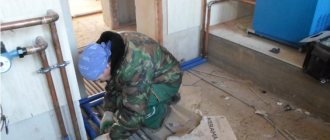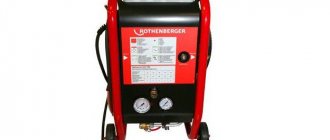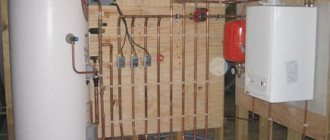The impossible is possible
So is it possible to refuse central heating in a city apartment, despite such compelling counterarguments? Yes, but with certain restrictions.
Collective shutdown
The current housing legislation still provides for the transition to autonomous heating, but only for the whole house or (if there are several elevator units in the house) an entrance. The elevator is either completely disconnected from the heating main, or (if it has hot water supply connections) is cut off from the heating circuit with the valves shut off using pancakes and the flanges sealed.
How to refuse heating in an apartment with a house or entrance?
Here are short instructions for this quest.
- A general meeting of residents is held. The result of the meeting is recorded in the minutes.
The protocol is certified by the signatures of all residents.
- A conciliation commission is created at the local government body, to which this protocol is submitted along with the application to disconnect the central heating system.
- If a positive decision is made, the commission gives the residents’ representative a list of organizations from which technical conditions for drawing up the project are required.
- Specifications are transferred to the design organization.
- Once the project is completed, it is accepted by each organization on the list. What kind of approvals are needed?
| Organization | Subject of agreement |
| Heating networks | No threats to the heating supply of part of the house or surrounding houses when a group of apartments switches to autonomous heating |
| Gorgaz | No overloads of gas lines during operation of gas heating boilers |
| Energy company | No overloads of power supply lines when switching to electric heating |
| Department of Architecture | No damage to buildings that are architectural monuments when installing coaxial pipes for air intake and exhaust of combustion products |
| Housing organization | Technical feasibility of stopping centralized heat supply, absence of threats to load-bearing structures |
If your house is a listed building, you will probably be refused.
- After the project is accepted, it is transferred to a licensed organization to carry out the work.
- After their completion, the result is again accepted by representatives of all interested organizations.
Individual shutdown
Is it possible to refuse heating in an apartment individually, regardless of neighbors? Relatively recently, a loophole appeared in the legislation that allows this to be done, despite the active opposition of local authorities. Its existence has already been confirmed by several court decisions in favor of residents.
The Law of the Russian Federation “On Heat Supply” (Article 14, paragraph 15) uses the following wording: “The transition to an individual heating scheme using heat sources, the list of which is determined by the current connection rules... excluding cases arising from the heat supply scheme,” is prohibited.
The full text of the law can be easily found in a bookstore or online.
The list itself (of course, not specific models of equipment, but requirements for them) is contained in Resolution No. 307 of April 6, 2012 (clause 44).
According to the decree, the use of boilers that do not meet the following requirements is prohibited:
- The gas boiler burner must be closed. The air intake must be organized from the street.
- The boiler must have protection against overheating of the coolant and against gas leakage when the burner flame goes out.
- The operating temperature in the water heating circuit during boiler operation should not exceed +95C, operating pressure – 1 MPa.
Finding a device that meets these conditions is not a problem.
It is worth proving that the boiler you purchased satisfies all the above conditions - and the refusal to switch to individual heating will be recognized by any court as having no legal force.
What to do after receiving a court decision? The answer can be found in the Housing Code (clause 25, clause 26). IN
The conciliation commission is provided with:
- Application for refusal of central heating.
- Housing registration certificate.
- A document certifying ownership.
- Written consent of family members to refuse the CO.
- Pre-obtained permission from the Department of Architecture.
- Detailed design of individual heating and a diagram for changing central heating communications in your apartment.
After receiving permission, all that remains is to submit an application to the local housing organization and pay for the dismantling of the heating devices. Jumpers are installed instead of batteries. This is where your love affair with district heating ends.
The heater has been cut off. It remains to muffle the eyeliners.
Possibility of switching to autonomous heating
If you don’t like the operation of a centralized heating system, then there is a way to switch to autonomous heating of your home. But, as mentioned earlier, such work has a number of obstacles: it is especially important to obtain appropriate permission to carry out such work, since any replacement of central heating pipes must be under the control of special authorities of the housing and communal system.
YouTube responded with an error: The request cannot be completed because you have exceeded your quota.
We recommend: How to connect central heating in a private house?
- Related Posts
- How to write a refusal of central heating in favor of individual heating?
- Features of the payment for central heating with autonomous heating
- Under what conditions is central heating turned on?
- How is central heating connected in a private house?
General information about central heating
Features of operation
First, let's look at the fundamental points that determine the operation of heat supply according to the scheme described here.
Schematic representation of the system
- With centralized heating of apartments or private houses (yes, such options are also sometimes implemented), heat is generated in a room other than the one in which it is consumed.
- The place of thermal energy production is a thermal power plant or a district boiler house, from which the heated coolant is supplied through pipelines to the apartments of heat consumers.
- Heat supply systems can be water and steam; accordingly, steam or hot water boilers are installed in boiler rooms. Boilers are heated by burning fuel - gas, fuel oil, coal, wood waste, etc.
- After the coolant (water or steam) reaches the required temperature, it enters the pipeline system, through which it is transported to the heating radiators in consumer apartments. The water is cooled in the radiators, after which it returns through the return circuit to the boiler room.
Boiler room with modern equipment
Boiler houses and thermal power plants also have a procedure for chemical water purification. Dissolved oxygen and carbon dioxide are removed from the coolant, and water hardness is also reduced. This is done in order to minimize the formation of scale inside the pipelines, as well as to reduce the intensity of corrosion processes.
Pros and cons of a centralized scheme
Despite the fact that the centralized heating scheme is considered by many to be ineffective (and we will see why below), it has several quite objective advantages:
Firstly, the cost of producing thermal energy on a large scale will be lower than with individual heating. In this case, you will not need to purchase heat-generating equipment, install it yourself or with the help of specialists, perform settings, etc.
Photo of a hot water boiler
- Secondly, central heating installations can run on relatively cheap fuel, which further increases the economic effect of their use.
- Boiler houses use fairly reliable heating equipment, which quite often allows the use of different types of fuel. This increases the level of system fault tolerance.
- Since heat generating enterprises are located at a distance from the heated facility, residential apartments are not polluted by fuel combustion products.
However, against the backdrop of these advantages, there are quite significant disadvantages:
- Central heating is characterized by impressive volumes of heat loss both during the production of heat and during its transfer to the point of consumption. During the passage of a multi-kilometer pipeline, the water has time to cool, so in order to maintain a comfortable temperature in the apartment, it is necessary to spend significantly more fuel than in the case of autonomous heating.
- It is almost impossible to control the temperature in the room: all adjustments are made in the boiler room itself. So, either a situation with underheating or the opposite situation may arise, when, at a completely acceptable external temperature, the heating radiators heat up excessively.
Also, do not forget about financial issues. The dynamics of heating tariffs in our country are very difficult to predict, which is why many people prefer to decide for themselves when they need to heat their home and how much they are willing to pay.
Types of heating boilers
Most hot water boilers are designed the same way; They differ mainly in power and manufacturer (for example, domestic and foreign). However, according to their design, they can be classified into:
- fire tube;
- water tube
The first are distinguished by the presence of special tubes through which heated fuel combustion products move. Such units use special automatic burners equipped with blower fans.
Water tube boilers have boiling tubes through which water is already moving. The energy carrier is burned and heats the water. All this contributes to the fact that the device warms up quite quickly, and the heating is easy to regulate. In addition, such structures provide for the possibility of strong overloads, which significantly reduces the likelihood of their explosion.
Hot water boiler
Hot water boilers usually have one or two circuits. In the second case, the heated coolant can be supplied to the water supply network or to the heated floor. Sometimes such boilers are already equipped with expansion tanks and circulators, which provide intensive water circulation.
Water heating boilers are classified according to the type of fuel used into:
- solid fuel devices in which the energy carrier is wood, sawdust or coal. Such boilers can be installed in a country house, in a bathhouse or sauna, because they require enough space;
- Liquid fuel boilers operate on machine oil, fuel oil or diesel fuel. They are used for heating cottages and private houses;
- Recently, the market for central heating boilers has been flooded with gas devices using natural or liquefied gas as fuel. Such units are suitable not only for a house or town house, but also for an apartment;
- Due to their compactness, electric water heating devices are perfect for both a private home and a city apartment.
We recommend: How to make a hydrogen heating boiler?
Depending on the installation method, the units can be either wall-mounted or floor-mounted.
Types of decentralized heat supply
Of course, building a separate boiler room, even a small one, is quite expensive. And the attic option is also not cheap. However, there is an alternative.
Modular boiler rooms
Block-modular boiler room
One of the very interesting projects is modular, or block, boiler rooms. There is no need to build anything, and only a small area is allocated for the boiler house. Blocks are brought here, which are easily and quickly connected into a finished structure
All of them are completed at the factory, the equipment inside them is precisely selected according to technical parameters, they are insulated and have a presentable appearance
The most important thing is to correctly configure and connect the equipment. A couple of days and the boiler room is ready
But only specialists should assemble it. If anyone remembers, such modular boiler houses were used to heat cabins and barracks, that is, temporary structures. After engineers and designers worked on them, such autonomous installations began to be used to organize heating in apartment buildings. However, this option is not the only one.
Wall boilers
The most effective and economical solution today is apartment heating, where wall-mounted boilers are used as a heating device. They run on either gas or electricity. Why wall-mounted?
Wall boiler
- Firstly, they are small in size, so they can be installed even in kitchens. At the same time, their appearance does not spoil the interior design at all.
- Secondly, wall-mounted heating boilers are real mini-boiler rooms. Their design includes a circulation pump, an expansion tank, as well as control and safety devices.
- Thirdly, such heating installations can have a power of up to 35 kilowatts, which allows them to heat rooms up to 100 square meters.
- Fourthly, modern manufacturers offer both single-circuit and double-circuit boilers for autonomous heating. So you will also be provided with hot water.
And now the important question is how to choose the right boiler? The main thing is to correctly select the unit according to its design features. It should contain all the devices we mentioned without exception - pump, tank, etc. In addition, it is necessary to have a chimney, which will ensure not only the removal of fuel combustion products in the case of gas boilers, but also the flow of clean air from the outside. This means that a wall-mounted gas boiler must have a closed combustion chamber. And the last thing is full automation, which will not only simplify the operation of the boiler, but will also save on fuel.
Of course, with gas boilers there are more problems when connecting. But electric analogues are simpler in this regard. Here you only need to draw a branch from the distribution panel with the installation of the machine and connect to the water supply system.
What might cause difficulties?
Modern kitchen
It may seem that everything is very simple and profitable. Then why don’t tenants switch to this heating system? And no one gives them permission. Imagine that the residents of one house will immediately submit documents for the re-equipment of heating networks, or rather, to refuse the services of organizations that supply heat to their houses. This is, firstly, a disaster for such an organization and deprivation of its profits. And, secondly, job cuts, although this issue is controversial. Someone needs to maintain autonomous mini-boiler rooms. So, in many respects, any of these options is not profitable for management companies. Although on a national scale, it’s the other way around. But it’s not for you and me to decide this issue.
Technical aspects of the issue
Having received the necessary permits, you can begin the technical implementation of the project. Dismantling of elements of the old heating system should only be carried out by specialists. Of course, you can cut the batteries yourself, but it’s better not to risk it. After dismantling the old system, all that remains is to install autonomous heating. In general, the implementation of such a project is no different from the installation of boiler equipment in country houses and cottages.
Despite the fact that such work, as a rule, does not cause difficulties, you should know a few nuances regarding the installation of heating systems specifically in apartments:
- To install autonomous heating in apartments, as a rule, wall-mounted boiler equipment is used. Such a boiler is located above the level of the radiators, so it is impossible to ensure natural circulation of coolant in the system.
- There are two ways to ensure forced circulation - by installing a circulation pump or a modern boiler, in the body of which all the necessary elements are already installed. These are pumping equipment, a safety group and an expansion tank. The second method is preferable.
- The type of boiler must comply with the law, that is, have a closed combustion chamber and automatic safety systems. The coolant temperature should be no more than 95 degrees, and the pressure in the system should be no more than 1 MPa.
- It is better to choose aluminum radiators for autonomous systems. They are not only reliable, but also have good heat dissipation. Plastic pipes are well suited for the piping system - they are inexpensive and easy to install.
- The wiring is selected based on the characteristics of the apartment. It is easier and cheaper to make a single-pipe Leningrad wiring with parallel connection of radiators. The optimal type of wiring from an operational point of view is radial, but it cannot always be implemented in apartments with low ceilings, since the floor will have to be raised.
Disconnecting radiators from central heating
When disconnecting a separate apartment from central utility networks, it is not always possible to completely redo the wiring. In most cases, it is not possible to shut off the riser, so only radiators can be disconnected from the circuit. This method of disconnection has its own nuances.
The apartment will still receive heat from the sun loungers and risers of the central system, and you will have to pay for it. The presence of common water circuit pipes in an apartment is always considered residual heating, and by law you must pay for it. This problem does not happen in houses where risers were originally installed in the entrance. In practice, such a water circuit does not occur very often.
Radiators can be connected with or without bypass. In the first case, the coolant will circulate through the bypass, which allows you to turn off some of the batteries. Such systems have proven themselves well with single-pipe wiring with parallel connection of radiators. After all, a reduction in the number of the latter leads to an increase in the temperature of the coolant in the system. Connecting batteries without using a bypass is actually a way to plug the circuit. This method can be used in risers.
Indoor heating devices and temperature conditions
The type of batteries installed in apartments depends on the year the building was constructed. If it was built in Soviet times, then the apartments will use one of the following types of radiators:
- metal convectors, which have a steel body, inside of which there are coils of DU-20 pipes and connected by a cross section;
- cast iron sectional batteries, which not only weigh a lot, but also have high heat transfer. Each radiator provides up to 150 W. Their disadvantages include the risk of leaks and unattractive appearance.
The dimensions of radiators or compartments in them depend on what floor the apartment is located on and what type of coolant circulation in the house. For example, if it is upper, then the coolant, reaching the first floor, will lose its temperature. It turns out that in order for the heating of an apartment building to be productive, in an apartment, if it is located on the ground floor, it is necessary to increase the number of compartments or install large radiators.
In modern multi-storey buildings, bimetallic radiators are usually installed. But this is the case if the heating system is water.
Such radiators are made of aluminum and have good heat dissipation, which is about 200 W per battery. But the price of such batteries is high. But the efficiency is great. Many people ask the question whether it is necessary to install bimetallic radiators or not. Everyone must answer this question for themselves, deciding for themselves whether they are willing to spend money to obtain heat.
The temperature regime in the apartments is indicated in the existing SNiP regulations. With central heating it is:
- bathroom – 25 degrees;
- living rooms and bedroom – 20 degrees;
- kitchen - 22 degrees;
- corner rooms - 22 degrees.
We recommend: Under what conditions do you turn on central heating?
The maximum water temperature in the heating system pipes is also set. It should not be higher than 95 degrees. Centralized heating of an apartment building allows you to efficiently heat the room, but at the same time, the temperature in the apartment completely depends on the operation of the boiler room and other external factors. In this, this system is completely inferior to autonomous heating, which is devoid of this disadvantage.
Classification of central heating systems
The variety of central heating organization schemes that exist today makes it possible to rank them according to certain classification criteria.
By thermal energy consumption mode
- seasonal, heat provision is required only during the cold season;
- year-round, requiring constant heat supply.
By type of coolant used
- water - this is the most common heating option used to heat an apartment building; such systems are easy to operate, allow you to transport coolant over long distances without deteriorating quality indicators and regulate the temperature at a centralized level, and are also characterized by good sanitary and hygienic qualities.
- air - these systems allow not only heating, but also ventilation of buildings; however, due to the high cost, such a scheme is not widely used;
Figure 2 – Air circuit for heating and ventilation of buildings
steam - considered the most economical, because small-diameter pipes are used to heat the house, and the hydrostatic pressure in the system is low, which makes it easier to operate. But such a heat supply scheme is recommended for those objects that, in addition to heat, also require water vapor (mainly industrial enterprises).
According to the method of connecting the heating system to the heat supply
independent, in which the coolant (water or steam) circulating through the heating networks heats the coolant (water) supplied to the heating system in the heat exchanger;
Figure 3 – Independent central heating system
dependent, in which the coolant heated in the heat generator is supplied directly to heat consumers via networks (see Figure 1).
According to the method of connection to the hot water supply system
open, hot water is taken directly from the heating network;
Figure 4 – Open heating system
closed, in such systems water is drawn from a common water supply, and its heating is carried out in the central network heat exchanger.
Figure 5 – Closed central heating system
How to refuse according to the law of the Russian Federation
Disconnecting a home from central heating is a time-consuming and costly process. To do this correctly, it is necessary to comply with the requirements of the law and step by step go through the difficult stage of project approval.
List of questions needed to be resolved
To turn off the heating you must:
- gain the approval of neighbors;
- obtain permission for reconstruction;
- contact specialists to create a redevelopment project;
- agree on the project;
- collect a package of documents;
- technically implement the plan.
When deciding to switch to individual heating, you need to decide which one. Since clause 15 of Art. 14 of Federal Law No. 190 of July 27, 2010 “On Heat Supply” prohibits the transition to individual heating in an apartment building when using thermal energy sources, the list of which is approved by Government Decree.
Neighbor permissions
In this case, the neighbors must allow the innovation; the issue is discussed at a meeting of residents.
When communications are not property of the house, the opinions of neighbors do not matter. You can immediately proceed to obtaining permission from relevant organizations. It will be necessary to make changes to the technical passport of the house.
Documentation
Article 26 of the Housing Code of the Russian Federation gives owners the right to disconnect from central communications. To do this, you need to collect a package of documents:
- Statement. It is written in free form; it needs to state the request to disconnect the apartment from centralized heating and justify it.
- Technical passport of the living space.
- Certificate of ownership.
- Written consent of adults living in the apartment.
- Conclusion on the technical feasibility of such changes.
- Coordinated reconstruction project.
Reconstruction project
The document on redevelopment of the heat supply of an apartment or house is carried out by a design organization or institute with the appropriate license on a contractual basis. To do this, use professional instructions and comply with the requirements of the law. Specialists will make calculations and monitor the effect of the apartment’s heating elements on the heating of the house.
Thermal-hydraulic calculations and calculations of residual heating from risers and sunbeds are also performed.
If, according to the results, installation of a separate boiler is possible, the project should be submitted for approval. If experts admit that canceling apartment heating will worsen the neighbors’ thermal conditions, it will not be possible to agree on the document.
Where to contact
Local government bodies - the administration of a city, town or district - are the authorities where you need to contact to obtain permission to reconstruct the heat supply system. These issues are dealt with by the department responsible for the use of housing stock. To do this, you need to provide there the collected documents and an application.
After the project is approved and completed, it is necessary to invite utility services and draw up a statement stating that the service is no longer provided and there should be no charges for it.
Deadlines
The timing of the shutdown depends entirely on the wishes of the initiator, since the law places on his shoulders all the costs of re-equipping the heating system in his living space. He is also obliged to establish normal operation of the heat supply in adjacent apartments. Accordingly, the owner independently searches for project contractors, enters into an agreement with them and pays for the work. It is clear that the whole process should not occur during the heating season.
A legal way to disconnect from the “common boiler”
So, the local government organization refused to disconnect you from the centralized water heating. What to do now? It's simple, you need to act according to the law. Since you cannot confirm the fact that the housing and communal services did not explain anything to you about how to properly refuse central heating, there is no way to hold them accountable for this. But you can force everyone to fulfill their duties. To do this, you just need to find a way to resolve the issue according to the law. This is entirely possible, but there is a small catch.
Central heating can only be abandoned by a general meeting of residents. The fact is that if you are the only one who wants to log out of the system, no one will agree to let you go. Of course, the law provides for the possibility of independently heating just your apartment. However, this is a troublesome matter, unprofitable for you, and also requires permission and assistance from local governments, which they are unlikely to provide to you.
Therefore, try to explain to all other neighbors that it is not profitable for them to remain on state heating. And here it doesn’t matter whether you are a resident of a village or an apartment. The rules are the same everywhere, by which living is not very convenient and expensive.
So, let’s imagine that your neighbors have made the decision we need. In this case, it is necessary to collect signatures from residents confirming their decision to disconnect from the general heating of the village or apartment building. After collecting signatures, prepare a new plan for your own heating system. Then this protocol must be submitted to local government authorities, which will decide whether to refuse or allow your request in accordance with a number of rules.
And here it doesn’t matter at all whether housing and communal services workers like your idea or not. It is much more important that they cannot make a claim against you that your plan may damage the existing heating system. After all, it is a large chain, which includes many links. If you remove one link from a chain, it may fall apart. Therefore, the links must be replaced correctly or not touched at all. It follows that you (or the organization you find to perform this task) will bear the burden of responsibility for the operation of all central heating pipes.
Independent heat supply.
Take care not to overload power supplies and gas lines. You will need to install an additional line to replace your pipes that have left the system. With a plan for how you intend to implement this, you need to visit heating networks and gas distribution organizations. There you will hardly encounter problems, since they only need to approve the protocol.
The local government organization will give you a list of municipalities that you must visit in order to obtain permits from them.
Having resolved all the bureaucratic red tape, you can get to work. As soon as everything is ready, a consolidated commission from heating networks, gas companies, as well as other responsible organizations will inspect the finished separate heating system.
Residents of the cottage community face a slightly different task. It will be a little easier for them.
Central heating system
No one will argue that the centralized system of supplying heat to apartment buildings, in the form in which it now exists, is, to put it mildly, morally outdated.
It's no secret that losses during transportation can reach up to 30% and we have to pay for all this. Refusal of central heating in an apartment building is a complex and troublesome procedure, but first, let's figure out how it works.
Heating a multi-storey building is a complex engineering structure. There is a whole set of drains, distributors, flanges that are connected to a central unit, the so-called elevator unit, through which the heating in an apartment building is controlled.
Two-pipe heating circuit.
There is no point in talking in detail about the intricacies of the operation of this system now, since this is done by professionals and the common man simply does not need it, because nothing depends on him. For clarity, it’s better to consider the heat supply diagram to the apartment.
Bottom filling
As the name implies, the distribution scheme with bottom filling provides for the supply of coolant from bottom to top. Classic heating of a 5-storey building is installed exactly according to this principle.
As a rule, the supply and return lines are installed around the perimeter of the building and run in the basement. The supply and return risers, in this case, are a jumper between the mains. This is a closed system that rises to the top floor and descends again to the basement.
Two types of bottling in comparison.
Despite the fact that this scheme is considered the simplest, putting it into operation is a troublesome task for mechanics. The fact is that at the top point of each riser, a device for bleeding air, the so-called Mayevsky valve, is installed. Before each start, you need to bleed the air, otherwise the air lock will block the system and the riser will not be heated.
Important: some residents of the upper floors try to move the air release valve to the attic so as not to have to deal with housing and communal services workers every season. Such alterations can be expensive. The attic is a cold room, and if you stop heating for an hour in winter, the pipes in the attic will freeze and burst.
The attic is a cold room, and if you stop heating for an hour in winter, the pipes in the attic will freeze and burst.
A serious disadvantage here is that on one side of the five-story building, where the input passes, the batteries are hot, and on the opposite side they are cool. This is especially felt on the lower floors.
Option for connecting radiators.
Top filling
The heating device in the nine-story building is made according to a completely different principle. The supply line, bypassing the apartments, is immediately carried out to the upper technical floor. An expansion tank, an air release valve and a valve system are also located here, allowing the entire riser to be cut off if necessary.
In this case, the heat is distributed more evenly across all radiators in the apartment, regardless of their location. But here another problem emerges: the heating of the first floor in a nine-story building leaves much to be desired. After all, having passed through all the floors, the coolant reaches downstairs already barely warm; this can only be combated by increasing the number of sections in the radiator.
Important: the problem with freezing water on the technical floor, in this case, is not so acute. After all, the cross-section of the supply line is about 50 mm, plus in the event of an accident, you can completely drain the water from the entire riser in a few seconds, you just need to open the vent in the attic and the valve in the basement
Temperature balance
Of course, everyone knows that central heating in an apartment building has its own clearly regulated standards. So during the heating season, the temperature in the rooms should not fall below +20 ºС, in the bathroom or in the combined toilet +25 ºС.
Modern heating of new buildings.
Due to the fact that the kitchen in old houses is not very large, plus it is naturally heated by periodic operation of the stove, the permissible minimum temperature in it is +18 ºС.
Important: all the above data is valid for apartments located in the central part of the building. For side apartments, where most of the walls are external, the instructions prescribe an increase in temperature above the standard by 2 - 5 ºС
Heating standards by region.
Types of heating systems
Depending on the characteristics of the wiring inside multi-storey buildings, engineering complexes are distinguished
Monotube
Such a central heating system is a line closed on the boiler, to which devices are connected in series. On the one hand, this is convenient in terms of project development and implementation in practice, as it allows the utility organization to save on pipes, fittings, and fittings. But for the user this scheme has a number of disadvantages
- uneven distribution of heat between individual apartments. As water moves from one radiator to another, it releases energy and cools. Recent consumers receive it almost cold
- impossibility of adjustment. It is impossible to change the power of the device individually by installing a thermostatic valve, as this will affect the operation of all subsequent radiators in the chain
As a result, there is an excessive consumption of heat in some areas and a lack of heat in others.
Double pipe
This central heating has a more efficient principle of operation, since it assumes the presence of two lines: supply and return. Each device in the apartments is individually connected to them. From the first line, hot coolant enters it, into the second it is discharged back to the boiler, and not to the next radiator in the chain. The costs of organizing the complex are increasing, but users can appreciate the increased operating comfort. It manifests itself in the following moments
- equal energy receipt by all consumers, which eliminates temperature imbalances between individual apartments and floors
- the ability to individually regulate the power of devices regardless of the operation of the others
- convenient disconnection of radiators from the system for repairs without stopping the operation of other elements
Central heating of apartment buildings
Through main pipelines, coolant from the central boiler room is supplied to the heating unit of an apartment building and is further distributed among the apartments. In this case, additional adjustment of the degree of hot water supply is carried out directly at the heating point, for which circular pumps are used. This method of supplying coolant to the end consumer is called independent (more details: “Central heating is both pros and cons”).
In addition, dependent heating systems are used in apartment buildings. In this case, the coolant is transported to apartment radiators without additional distribution directly from the thermal power plant. In this case, the water temperature is determined regardless of whether it is supplied through a distribution point or directly to consumers.
Operating principle of central heating
Scheme of a closed single-pipe system in an apartment building.
The air temperature is measured in the CHP department. It is by this that utility workers determine the moment at which hot water supply is needed. Sometimes this is done on calendar dates (there are certain times of the year at which local governments are required to turn on central heating). But it also happens that cold weather comes much earlier than the deadlines established by law. Low temperatures are often ignored by local authorities, but if it gets too cold, the central heating is turned on ahead of schedule.
From this same thermal power plant, water flows into separate boiler houses attached to apartment buildings. There it is heated taking into account how low the temperature is in a given location. Of course, all apartments are heated from one boiler, which poses a problem. The liquid becomes extremely hot and only then goes down the pipes. This is done so that residents of the last houses can receive water that has not yet been completely cooled. Of course, thanks to this approach, the temperature is distributed in a strange way. Residents of those apartments through which water runs first have to endure unbearable heat. They cannot open the windows because it is minus outside, and quite low at that. But it is impossible to keep them closed, because the air becomes so dry that even plants die. It's a tough situation, isn't it?
I wonder why, if everyone is so hot, school and hospital staff constantly complain that their water temperature is always low? It is not known why, but in accordance with the procedure established by law, hospitals are supplied with a minimum water temperature from the central heating battery. This applies not only to these municipal institutions, but also to all public places that are maintained at the expense of the state. Simply put, the more budget the premises, the less is spent on its maintenance.
Of course, after reading everything said above, you may decide that there are no advantages to this method of heating our homes. Of course, this opinion will be wrong. After all, it still functions and is beneficial. Let's look at the most important advantages that central heating has.
The benefits of central heating
Home balancing system "Autobalance".
Let's say right away that there are not many positive aspects and some of them are very controversial. For example, cheap fuel. Indeed, when using central heating boilers, only energy resources are used, on which large amounts of money are not spent. Sounds funny, doesn't it? It seems like they heat us with coal, fuel oil and other cheap means, but they charge us money as if for gas, or even gasoline. But, whatever one may say, there is such a plus. Although it is beneficial, for the most part, not to us.
However, there are also points of interest for residents of apartment buildings. Well, for example, high reliability. Seriously, think for yourself, after all, having installed your own boiler, for example, in a private house, you will have to constantly monitor it. What if there is a gas leak or some kind of breakdown. Or maybe it’s central heating, which is under the supervision of housing and communal organizations. Although, of course, nowadays everything is possible. The bureaucratic apparatus has become so lazy that sometimes it takes money but does not carry out repairs. Therefore, if you think about it, this plus can also be called controversial.
And again it seems that centralized heating has no positive aspects. But there is still something. It's about sustainability! Well, think for yourself, can the above fuel sources be dangerous? Of course not! But what difference does it make whether the state boilers will use them or our own? After all, if we are talking about heating a cottage community in which centralized heating predominates, then you can independently install economical boilers that run on coal and heat the owner separately from the general system. And if we talk about apartment buildings, then. We will tell you below what can be done for apartment residents.
So, now it becomes clear that supporters of the idea of leaving general heating from the state have only one argument. It's simplicity that lasts. After all, all that is required of you is to pay large expenses. Everything else is supposedly done by the housing and communal services sectors. But it’s very, very unclear why such a lot of money is being taken.
Differences between one-pipe and two-pipe systems.











